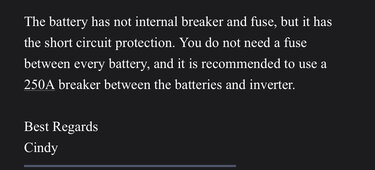robbob2112
Doing more research, mosty harmless
That is great to hear that the insurance company actually does what they are supposed to do. What brand? Your experience is a good endorsement and counter to the usual horror stories.
He is in Belgium so they may have greater protect for consumers than in the US.
Here they would pay for the fire, add a surcharge if it was negligence then cancel your policy once you were done rebuilding.
I'm more concerned about his fuse holder setup. What is the backer they are attached to? I've also seen mention that "Victron recommends this fuse". Well, yes, but you also have to look at how they are installed.
When you compare with a Victron megafuse holder:
View attachment 215746
View attachment 215747
His fuse holders were red, flame resistant and had covers to seal them up. Not much different than the Victron version. There is one picture with part of them with covers on.
Not sure if they had the interlock or not, but were mounted side by side.
The backer appears to be OSB or equivalent - so not ideal, but many people are using similar - so common practice even though it could be a factor.
We will never know for sure -
I choose to believe a shorted cell vented and blew the fuse then caused an arc and set off the vent gasses.
contributor was the single contactor verse 7 IMO and Mega verse class T or other arc supressing fuse.
From the math a couple of us did the temperature of the wire connecting the fuses may have been high enough to melt the sheath off, temp rise in under a second to over 200c.
Last edited:




